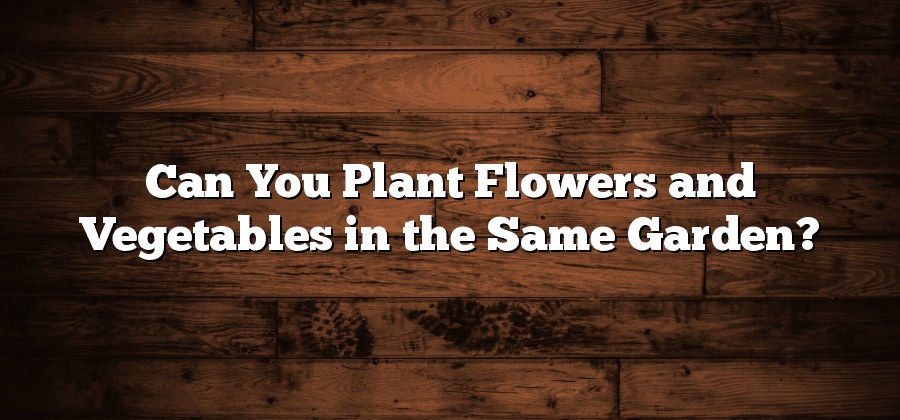Advantages of Growing Flowers and Vegetables Together
Flowers and vegetables may seem like an unusual pairing in a garden, but there are numerous advantages to growing them together. One of the main benefits is the promotion of pollination. Flowers attract bees, butterflies, and other pollinators, which in turn help to fertilize the vegetable plants. This results in increased fruit production and a healthier garden overall.
Another advantage of growing flowers and vegetables together is pest control. Certain flowers, such as marigolds and nasturtiums, have natural pest-repelling properties. When planted among vegetables, they act as a barrier, deterring pests from feasting on the crops. Additionally, certain flowers can attract beneficial insects like ladybugs, which help to control harmful pests naturally. This creates a more harmonious and balanced ecosystem in the garden, reducing the need for chemical pesticides.
Benefits of Companion Planting in Gardens
Companion planting in gardens offers a range of benefits that can greatly enhance the health and productivity of your plants. One of the key advantages is natural pest control. By strategically pairing certain flowers and vegetables together, you can naturally deter pests without resorting to harmful chemicals. For example, planting marigolds alongside tomatoes can help repel nematodes and aphids, while basil can keep mosquitoes and flies at bay. This not only promotes a healthier garden environment but also reduces the need for chemical sprays, making it an eco-friendly choice.
Another benefit of companion planting is improved pollination. Certain flowers, such as sunflowers and zinnias, attract pollinators like bees and butterflies. By planting them near your vegetables, you increase the chances of successful pollination, leading to better fruit and vegetable yields. Additionally, some companion plants can act as trap crops, diverting pests away from your main crops and protecting them from damage. Overall, companion planting is a smart gardening technique that not only helps with pest control and pollination but also adds beauty and diversity to your garden space.
Choosing the Right Flowers and Vegetables
When it comes to selecting the right flowers and vegetables for your garden, it is important to consider several factors. One of the key considerations is the climatic conditions of your region. Different plants have different temperature and sunlight requirements, so it is crucial to choose varieties that are well-suited to your local climate.
Another important factor to consider is the space available in your garden. Some plants, such as cucumbers and zucchini, require more space to spread out and thrive, while others, like radishes and lettuce, can be grown in tighter spaces. Consider the size and growth habits of each plant when planning your garden layout to ensure that each plant has enough space to grow and flourish.
Understanding Plant Compatibility in the Same Garden
When planning a garden, it is important to consider the compatibility of the different plants that will be growing alongside each other. Plant compatibility refers to how well various plants coexist and interact with one another in the same garden. By understanding plant compatibility, gardeners can create a harmonious environment that promotes healthy growth and maximizes the potential benefits of each plant.
One key aspect to consider when assessing plant compatibility is the individual plant’s needs in terms of sunlight, soil conditions, and water requirements. Some plants may thrive in full sun, while others prefer partial shade. Similarly, different plants have varying soil preferences, such as acidic or alkaline soil. By grouping plants with similar needs together, gardeners can ensure that each plant receives the necessary conditions for optimal growth.
Another factor to consider when assessing plant compatibility is the interactions between plants themselves. Some plants have the ability to attract beneficial insects or repel harmful pests, which can be advantageous to neighboring plants. Additionally, certain plants have root systems that can help improve soil structure and nutrient availability, benefitting nearby plants. Understanding these interactions can lead to a more balanced and resilient garden ecosystem.
Overall, understanding plant compatibility plays a vital role in creating a successful and productive garden. By carefully selecting and grouping plants based on their needs and interactions, gardeners can create an environment that fosters healthy growth and maximizes the benefits of each plant.
Creating a Balanced Garden Ecosystem
The concept of a balanced garden ecosystem is rooted in the idea of creating harmony among the various plant species in your garden. When plants are carefully chosen and placed together, they can support and benefit each other’s growth and health. This practice, known as companion planting, not only improves the overall aesthetics of your garden but also has numerous ecological advantages.
One of the key benefits of creating a balanced garden ecosystem is enhanced pest control. Certain plants have natural abilities to repel pests, while others attract beneficial insects that feed on harmful pests. By strategically incorporating these plants into your garden, you can reduce the need for chemical pesticides and ensure a healthier and more sustainable environment for your plants. Additionally, companion planting can improve soil fertility by utilizing the concept of nutrient cycling, where different plants take up and release different nutrients, promoting a well-nourished soil. The result is healthier, more robust plants with increased resistance to diseases and improved overall productivity.






